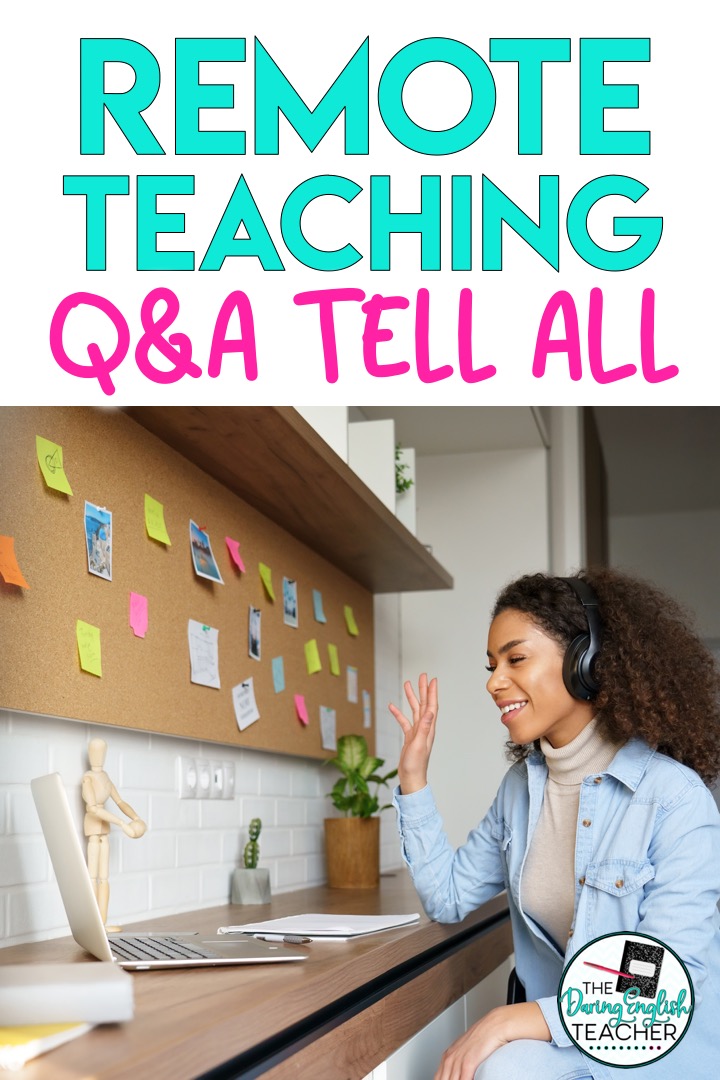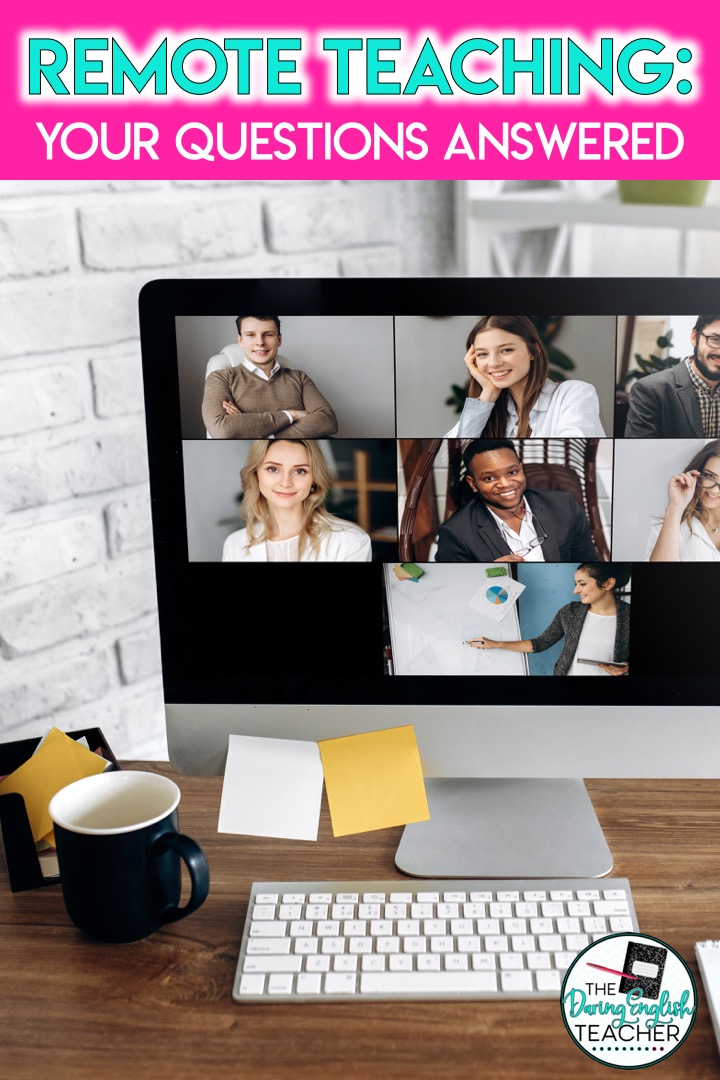Complete distance teaching high school English is so much different than teaching in-person. To effectively teach remotely, I have to modify everything I know about teaching, from classroom management to teaching strategies. And I am quickly learning that just when I feel like I am getting the hang of it, there’s a change or a pivot in the plan. However, for now, teaching high school English remotely from the quietness of my empty classroom is what my day looks like.
Several weeks ago, I asked people what questions they had about my experiences teaching remotely. Since I go back to school earlier than many people across the nation, I am trying to share my remote teaching experiences as candidly as possible to help prepare other teachers for what’s to come. Compulsory distance teaching has been nothing short of a rollercoaster ride. This post is the second remote teaching QandA blog post I have. The link to the first blog post is at the end of this post.
How do you build classroom community through remote teaching?
I am four weeks into the school year right now, and if I am learning anything, I am learning that every aspect of remote teaching requires patience. I’m quickly learning that building classroom community through distance teaching doesn’t happen as soon as it does with in-person instruction, which is okay. So much of this will come with time. I’m doing a few things in my virtual classes to help make students feel seen, heard, and welcome.
One of the first things I did once we began content instruction was to survey my students via the poll option in Zoom. I wanted to know how distance learning was going for them, their struggles, and what was working -whether it was in my class or another class. From their responses, I made modifications to my Canvas course and teaching to benefit the students. I gave my students a voice and listened to them.
At the beginning of the school year, I assigned some welcome back, getting-to-know-you types of activities like my Digital Back-to-School Welcome Stations and my Free All About Me Class Introduction Activity.
To encourage discussion and participation and get to know my students, I am also doing a weekly fun Friday question where I ask my students a fun question that isn’t related to school. I have them share their response in the Zoom chat or unmute themselves as share aloud. I share my answer with my students, as well. So far, it is helping to encourage student participation. I share more about how I build classroom community in this blog post about starting the school year with remote teaching.
Do you stay in your Zoom meeting the entire block each day?
Yes. My school is currently on a block schedule with 90 minutes scheduled for each class period. Also, since I teach in California, our instruction must contain a specified number of synchronous minutes each day. I am finding that the easiest thing for me to do is stay in the Zoom the entire time. However, it is essential to note that I am not lecturing for all of those minutes.
I typically start my class period by welcoming the students in, showing them around Canvas (again), and introducing the assignment. For some of the more complex assignments, I am working through the first example or reading with them. I am a firm believer in the I do, we do, you do teaching strategy.
If I notice that I am lecturing for more than I’d like, I give my students a 2-minute stretch break. I tell them to get up, stretch their legs, grab some water, and then come back. I also walk laps around my classroom at this time. Once we move to independent work, I either place the students in individual breakout rooms, group breakout rooms or keep them in the main room. I tell my students that my mic is muted, and my camera is off, but that I am there for them if they have any questions. I use independent work time to check in on my struggling students and try my best to help with all SPED accommodations.
Toward the end of class, I give my students a 1-minute wrap-up reminder, and then at the minute mark, I bring them all back together. I have several students share aloud what they came up with, and then I also ask all of the students to respond with an answer in the chat. I usually end my class period about five minutes early. After I briefly review what we did in class and review what assignments they are working on, I let the kids know that they can exit the call if they don’t have any questions. I also tell my students that they can hang back in the Zoom if they have any questions. I use the last five minutes of each Zoom session, answering individual student questions. I am quickly finding that students are much more apt to ask questions at the end of the class period when fewer of their classmates are on the call.
How do you get students to turn on their cameras?
I do not require my students to turn their cameras on during instruction. It is still early on in the year, and I don’t feel like cameras on is necessary. Yes, I would absolutely love it if I could see all of my students’ faces on the Zoom call, but their privacy is much more important than me not wanting to teach to blank screens. Furthermore, some students do not have access to reliable, high-speed internet. For some of my students, if they turn their cameras on, their wifi speeds will be affected, and my voice won’t come through clearly. In some cases, having cameras turned on is an equity issue.
With that said, I am finding that students are more comfortable turning on their cameras in smaller breakout groups or individual breakout groups. Like I said in the previous question, for independent work, I sometimes like to have students go into their own breakout room by themselves. When students are in individual breakout rooms, I can hop from one room to another and have some one-on-one instruction time with each student. This Zoom strategy also works for getting to know each of my students and building classroom community.
How do you check for understanding without the cameras on?
To check for understanding on Zoom when students have their cameras turned off, I am using a couple of different strategies. I use and rely on the Zoom chat feature quite a bit. I pose several questions to my students in the chat feature every single class period. Another strategy I use is the discussions feature in Canvas. I organize all of my school content in Canvas in Modules, and we have a graded class discussion question almost every class period. I have the class discussions go into the grade book as a participation grade, and I grade them as complete or incomplete. In Canvas, I use the setting that requires students to post their answers before seeing their classmates’ responses. After students post their discussion answers, I encourage them to go in and read and comment on several other discussion posts to solidify their understanding of the concept.
How do you get students to interact with you during remote teaching?
I miss having student interaction in the classroom. I miss the class conversations, the group work, and the silly teenage antics. Remote teaching is so quiet. And I am quickly realizing how challenging it is to teach to a computer screen because you can’t adjust your lesson by your students’ reactions.
One way that I check to make sure students are following along is by using the Zoom reactions. If they are with me, I ask for a thumbs up. This check is a straightforward way to see which kids are actively following along in the class. The Zoom chat is another way I encourage students to interact. Also, when I call on students, I do not cold call on students to respond at all. Instead, I wait for volunteers, but I even let my students know that if they’ve chosen to keep their camera off, they can only speak and still have their camera off as they share. By doing this, I am noticing that more students are willing to share their answers aloud.
However, from my experience so far, the best strategy for getting students to engage with the content with remote learning is by placing them all in individual Zoom breakout rooms. There is less pressure on students to turn on their cameras and unmute their microphones when they feel safe.
When students do participate in class discussions or answer questions aloud, I thank them and point out what I liked about their answers. I want them to know that I listened, and I also want to tell the student and the entire class, what was strong about their response.
How do you handle students showing up late to the virtual class?
Policing tardies is not something I want to combat during remote learning. There are so many reasons why a student might be entering the Zoom call late, and there is absolutely no reason to point out late students to the class. I allow the students to enter into the Zoom from the waiting room, and then I continue with my lesson.
I’ve found that building in a buffer time at the beginning of the period helps with tardies, though. I don’t start my Zoom call until 10 minutes into the class period. I ask students to be in the waiting room 5 minutes before we start, and that is when I start taking attendance, but that is about it for now. Having this buffer time built into my lesson also allows me to respond to frantic student emails from all of the students with tech issues.
Does it get any better with students turning on their cameras?
Once again, this is where patience comes into play. I am finding that it is so important to have patience with remote teaching. To answer this question, yes and no. I am noticing that a few more students are turning their cameras on. I am also seeing that a few more students are willing to share aloud and contribute to class discussions. In a way, it is very similar to in-person teaching: each class is different. Some classes are more chatty, some classes have more in-depth conversations, some classes are quiet.
Do I allow students to unmute themselves?
Yes! I want students to participate and speak and share and ask questions. And, even as distracting as it is, if a student has a question mid-lecture, I’d rather have them interrupt me and ask a question than sit alone in their room confused. Besides, the chances are that other students might have the same question.
I’ll be answering more questions in a few weeks. If you’d like to read my first round of questions and answers, you can check out this blog post about my first two weeks of teaching remotely.




